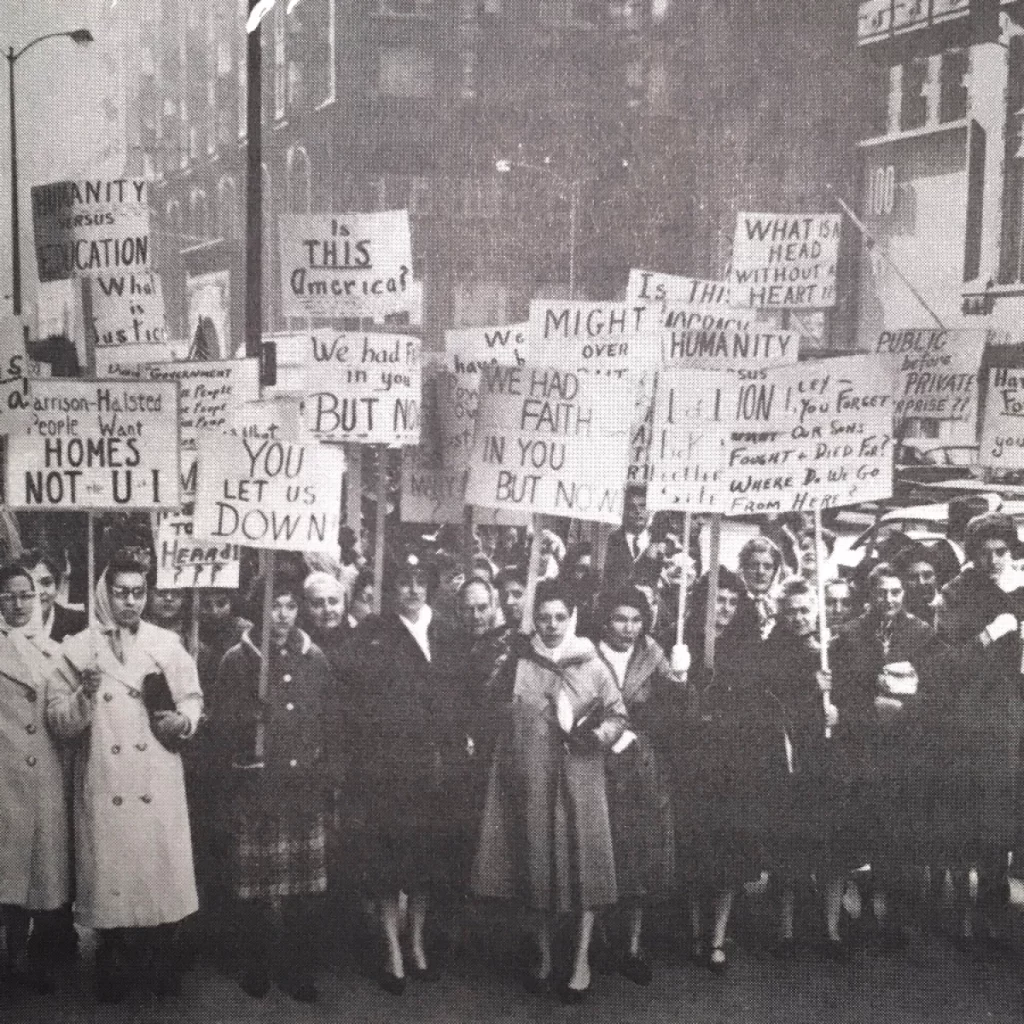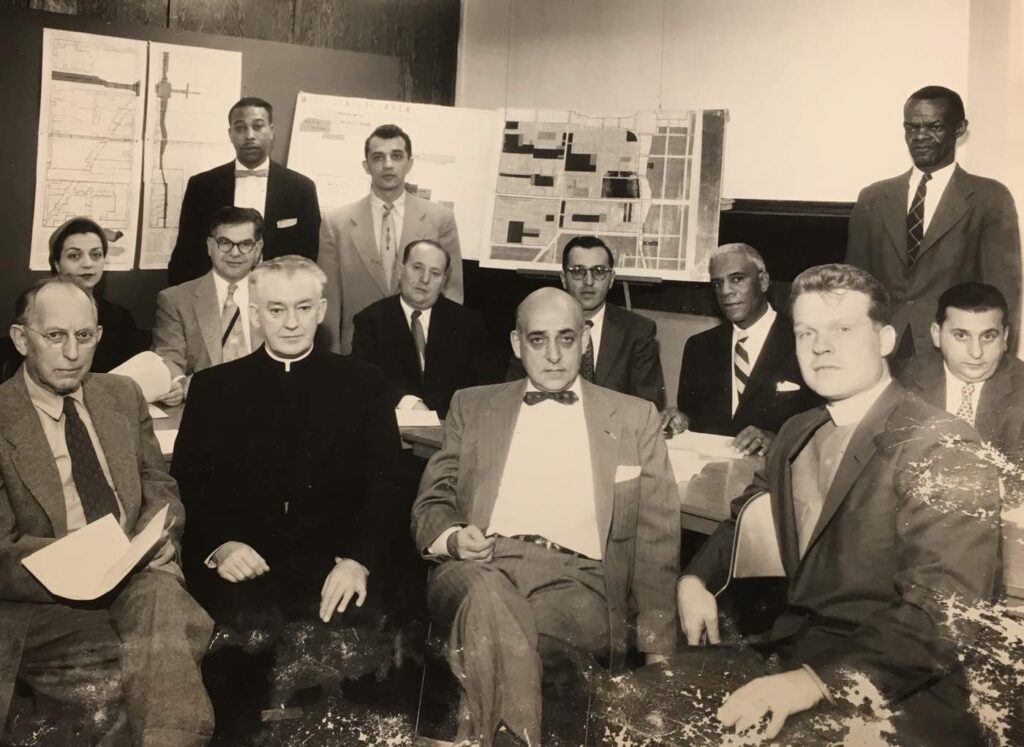It’s time to move. I’m not gonna ask you again; it’s for the greater good of the city!
Nov 26, 2024
By: Ulises Macias-Guerrero, University of Illinois at Chicago

Introduction
You live on the near west side of Chicago in Little Italy, on 923 S Carpenter near the University of Illinois Chicago Campus. Your Italian family of 10 are all cramped into the 1st floor of this apartment but still manage to carry out the life necessities to keep your family together. Suddenly, a City of Chicago urban renewal worker comes to your door on a Saturday morning and informs you that the government will purchase your home. You ask why? How are you capable of taking my home? What is the purpose of taking my home? The government worker responded that we would clear the rest of Little Italy by demolishing homes and expanding the University of Illinois at Chicago. Sounds chaotic and unjust. Well, that is precisely what occurred in the fall of 1959.
Urban Renewal and UIC
Many students attending the University of Illinois Chicago are unaware of the University’s need to demolish an entire “slum neighborhood” to build the new university. Although the Near West Side of Chicago had been designated for demolition, it was not the first choice to place the University. Various sites like the Railroad yards, Garfield Park, the golf course in Riverside, and Meigs field were considerted. Before 1959, Gage Park was the ideal choice for the city to purchase park land instead of homes.
Unfortunately, urban renewal was already in full swing, ready to demolish entire neighborhoods. The idea of urban renewal and urban redevelopment was formulated by city planners and government officials who sought to replace destroyed homes and deteriorating neighborhoods to create new complexes and business distractions.1 The city hoped to utilize the University of Illinois Chicago as a buffer zone between poor minorities and the luxuries downtown. Mayor Daley hoped to attract Suburban whites back into the city. How can anyone accept the idea of your neighborhood being demolished? What are the stories of people finding homes after their homes were demolished?

Sidewalk & tenement narratives
After the construction of major Urban renewal projects such as the University of Illinois Chicago, history seems to forget about those who once lived in the “slums” and the activists who fought back against the Daley machine, such as Florence Scala. As Jamin Creed Rowan notes, the “sidewalk narratives” referring to the culture and sense of community people shared on the streets rapidly disappeared, and families were forced to relocate and lost their homes, businesses, and cultural spaces. Meanwhile, “tenement narratives” gave way for urban renewal enthusiasts such as Richard Daley not to blame landlords for decaying homes, but rather for the economic and political systems people lived in. The quality of the buildings gave rise to the idea of slum clearance, in which the building of public housing superseded the revitalization of decaying buildings.2
- Alexander Von Hoffman, “The Lost History of Urban Renewal,” 2008, accessed December 2, 2024. ↩︎
- Jamin Creed Rowan, “Sidewalk Narratives, Tenement Narratives: Seeing Urban Renewal through the Settlement Movement,” Journal of Urban History, vol. 39, no. 3, 2013, pp. 392–410. ↩︎
A Place to Live Documentary exposing reality
The documentary “A Place to Live” is a hidden gem that gives viewers a sense of reality for what it was like post-urban renewal to search for a new home and lifestyle. More than 3000 families were displaced by urban renewal. Many of the displaced were families had been in their homes for as long as 15 years. 125 people were assigned to work with the families to understand their needs, affordability, employment, health, location, and personal problems. One of the only bright spots in urban renewal was the urban renewal case workers who listened to the people’s demands and attempted to meet their needs. Many families in the documentary were still distressed as they felt nothing could replicate their prior home and neighborhood where their children were raised.
The documentary shows many successful relocations of families displaced by urban renewal, but not those who may not have found a suitable home with cameras, and the producers were most likely pushing the successful relocation narrative. The Place to Live documentary is profoundly similar to the narrative created by the UIC Alumni Association in their Pier to Present video where the establishment of the university is oversimplified (Pier to Present 2022). Most families described how their new buildings met adequate living standards and were in better neighborhoods. Although some saw an improvement in living conditions, stories of families forced into inadequate living conditions or under distress because they could not find a home or new job were not mentioned.
Documentaries such as A Place to Live are informative about how the government handled the issue of attempting to relocate families to suitable locations. However, The documentary does not capture the inhuman situation of seeing your home bulldozed into pieces. At the same time, a university is built to enhance the reputation of a city while making the excuse that it is necessary to expand higher education, along with feeling scared and anxious about where your family will live after the demolition. As Chicago and the University of Illinois Chicago continue to develop and grow its student body population, surrounding areas see the effects of gentrification and the expansion of the UIC campus. For those displaced by higher taxes or prioritization of student housing rather than affordable housing, the impact of Richard Daley’s urban renewal project on the Near West Side continues to leave its effects.
https://digital.library.uic.edu/view/ark:/81984/d3bn9xc99?video=0&time=0

End notes
Alexander Von Hoffman, “The Lost History of Urban Renewal,” 2008, accessed December 2, 2024.
Jamin Creed Rowan, “Sidewalk Narratives, Tenement Narratives: Seeing Urban Renewal through the Settlement Movement,” Journal of Urban History 39, no. 3 (2013): 392–410.